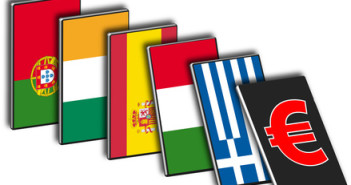In the never ending European debt crisis, the concept of bailouts has been used over and over again. Similar to the core debt problems, opposition is also mounting to unsustainable levels against the core solution: bailouts. Will we see disorderly defaults? Or perhaps a brave new solution?
The problem: The story was the same for Greece, Ireland and Portugal. Worries about their debt to GDP ratio grew, investors ran from their bonds and yields rose to high levels. With high levels of yields, funding costs became unsustainable.
The current solution: So the EU, ECB and IMF sat together with the troubled country, and worked on a funding plan. The condition for getting aid from this troika was a serious austerity plan that aimed to balance the debt in the long run, until the troubled country could return to the markets and return to normal.
The outcome for the poor: Even if the country fulfilled its obligations or not, the austerity measures hit hard and helped GDP shrink. In the case of the first country to get a “bailout”, Greece, the country’s finances deteriorated and the country needed a second bailout. Market access was denied.
The outcome for the rich: And what happened in the rich countries that paid for the bailout? At first, the public accepted the plans. But as time passes by and these programs don’t work, anger is growing.
Bailouts failed, and opposition mounts:
- Spain: Mass protests praised Iceland for refusing to “save” the banks. Iceland was significantly hit by the crisis, but got out of it quickly. Fresh debt issues are popping all the time in Spain.
- Italy: The ECB dictated austerity measures to Berlusconi’s government in exchange for the ECB’s bond buying. Italy didn’t want the fate of the smaller countries. But now, the parliament wishes to change these measures, and political tensions are rising towards a deadline to pass them.
- Finland: The demand of Finland from Greece, to get collateral for its bailout funds is far from being “off the table”. The Finns insist on it, and this triggers other rich countries to raise similar demands. If something like this is agreed, CDS could be triggered. If there only is a delay, the next tranche of aid might not be approved on time for Greece.
- Greece: Indeed, recent days brought Greek yields even higher. One year yields are at an astonishing 60%. This means that the market sees an imminent default.
- Germany I: The biggest country and the paymaster of the bailouts also sees rising internal trouble. Chancellor Angela Merkel’s coalition and also her fellow party members, are very reluctant to approve the July 21 agreements. They consist of fresh powers to the bailout fund – powers to but bonds in the secondary markets and recapitalize the banks.
- Germany II:The vote coincides with a ruling about the bailouts in the constitutional court at the beginning of September. If the court challenges the state, get ready for a serious turmoil.
It seems that the age of bailouts is over. Rich countries don’t want to pay and poor countries don’t want the austerity. It doesn’t work.
What can be a solution? Quantitative Easing – Printing euros if you wish. The “temporary” bond buying made by Trichet is a real success in stabilizing Italy and Spain. Both countries could raise funds at lower rates after the intervention to lower yields.
Trichet currently rejects real QE – buying bonds without sterilizing the actions. Will he be forced to do it? It’s getting closer.
Further reading: Dark Clouds Over European Banks
